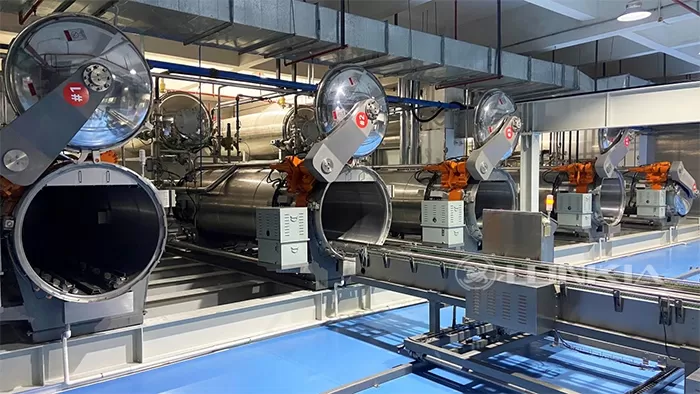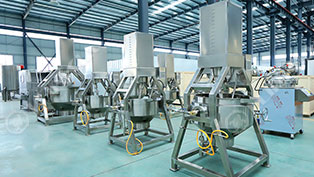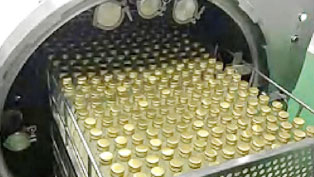When it comes to food processing and sterilization, retort systems are a critical component for ensuring food safety and shelf life. In recent years, water spray retorts have emerged as a popular alternative to traditional retort systems. But how do they compare? Which one is better for your business? Let’s dive into the key differences, benefits, and potential drawbacks of each to help you decide which system best suits your operations.
What is a Retort System?
A retort is a pressure cooker used in food processing to sterilize packaged products. The process involves heating food to a high temperature while sealing it in containers, which destroys harmful microorganisms and extends shelf life. There are two primary types of retort systems: traditional (steam) retorts and water spray retorts.
Traditional Retort Systems
Traditional retorts use steam to heat and sterilize the food inside sealed containers. The steam is injected into a chamber, and the pressure is raised to ensure the food is evenly heated to the desired temperature.

Advantages of Traditional Retort Systems:
- Proven Technology: Steam retorts have been around for decades and are well-tested, making them a reliable choice for many manufacturers.
- Large-Scale Production: These systems can handle large quantities of food at a time, making them ideal for high-volume operations.
- Consistency: Steam heat is effective at ensuring uniform sterilization, minimizing the risk of undercooked or unsafe food.
Drawbacks of Traditional Retorts:
- Energy Efficiency: Traditional steam-based systems tend to consume more energy due to the heating of large volumes of water and the steam generation process.
- Longer Processing Time: Steam-based systems often take longer to heat up and maintain the correct temperature, potentially affecting overall throughput.
- Product Quality: The use of steam can sometimes result in overcooking or a loss of flavor and texture, especially for delicate food items.
Water Spray Retort Systems
Water spray retorts, on the other hand, utilize pressurized hot water to heat and sterilize the food inside containers. Instead of steam, water is sprayed onto the containers, evenly distributing heat throughout the chamber.
Advantages of Water Spray Retort Systems:
- Faster Processing Times: Water conducts heat more efficiently than steam, which often leads to faster processing and shorter cycles. This can increase production capacity and efficiency.
- Energy Efficiency: Water spray retorts typically use less energy because they don’t require the generation of steam, which can be energy-intensive.
- Gentler on Food: Since water spray systems have more precise temperature control, they are less likely to overcook or degrade the quality of sensitive foods. This can help preserve the taste, texture, and nutritional content of the product.
- Lower Operating Costs: Water spray retorts often have lower operating costs due to reduced energy consumption and maintenance needs compared to traditional steam retorts.
Drawbacks of Water Spray Retorts:
- Limited Capacity: While they can still handle moderate to large batches, water spray retorts may not be as efficient for extremely high-volume production compared to traditional systems.
- More Expensive Upfront Costs: The initial investment for water spray retort systems can be higher due to the advanced technology and equipment needed.
- Water Usage: Although these systems are more energy-efficient, they do require a significant amount of water for proper functioning, which could be a consideration for some businesses depending on water availability and costs.
Which System is Right for Your Business?
The decision between water spray retorts and traditional retorts ultimately depends on several factors specific to your business:
- Production Volume: If your business operates on a large scale and needs to process significant quantities of food, a traditional steam retort might be the better choice due to its proven ability to handle high volumes.
- Energy and Cost Considerations: If you’re looking to reduce energy consumption and operating costs while improving processing speed, a water spray retort could offer significant advantages in terms of efficiency and cost savings.
- Product Type: For businesses that produce delicate foods that require careful handling (e.g., fruits, vegetables, or ready-to-eat meals), a water spray retort is often the better option due to its gentler and more precise heating method.
- Budget: If you are working with a limited budget, a traditional retort might offer a more affordable entry point. However, keep in mind that the long-term savings from a water spray retort system might outweigh the initial investment if your business benefits from increased efficiency and product quality.
Conclusion
Both water spray and traditional retort systems have their pros and cons, and the best choice for your business will depend on factors like production volume, product type, and budget. While traditional retorts remain a reliable and proven solution for many manufacturers, water spray retorts are quickly gaining popularity due to their energy efficiency, faster processing times, and gentler approach to food sterilization. By carefully evaluating your specific needs, you can select the retort system that will help you maximize productivity while maintaining the quality of your products.



